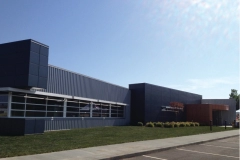How High-Speed Fiber Networks Can Future-Proof Data Centers
How High-Speed Fiber Networks Can Future-Proof Data Centers
Data centers are evolving from centralized facilities into a decentralized network of resources tied together by a robust cloud infrastructure. This launches our special report series on how high-speed fiber networks can future-proof distributed data centers.

Get the full report
The rapid growth of cloud services has created a popular impression that data centers are dinosaurs. In reality, the market is robust and growing. Gartner expects global data center spending to increase 5.3% in 2022 and to continue steady growth through at least 2024.
But future data centers will look quite different from their predecessors. Historically, data centers were large, centralized facilities intended to serve an entire company or a large geographic region. With the arrival of cloud infrastructure, that model is being replaced by a fabric of resources distributed across the globe to handle constantly shifting workloads according to the organization’s need for availability, responsiveness, scalability, and security.
Growth in the use of intelligent devices — also called the internet of things — will drive that market to more than double to $1.06 trillion in 2030, according to Statista. This, in turn, is spurring the evolution of a new approach to infrastructure that moves computing closer to the points at which data is collected and disseminated, a topology called “edge computing.”

Source: Gartner

Source: Statista
This trend will grow as computing power becomes more distributed to meet the demands for faster response times, analytic workloads, and real-time processing for such purposes as remote equipment monitoring, predictive maintenance, real-time logistics, rapid health diagnostics, and securities trading.
Data growth creates complexity
The drive to digitally transform businesses to data- driven decision-making has organizations focusing intensely on how they can better capture and leverage data, even as volumes are growing at a 23% compound annual rate, according to International Data Corp. The more data that is generated, the more resources are needed to manage it.
Cloud platforms have given organizations a bounty of new choices about where and how to store and process that information. However, few are willing to put all their data processing eggs in a single cloud basket. On average, enterprises use 2.6 public and 2.7 private clouds, according to Flexera.
The result is that data processing facilities and resources are growing across the board.
In addition to the data center growth cited earlier, worldwide end-user spending on public cloud services is forecast to grow 20% in 2022 to $397.5 billion, according to Gartner. Colocation services are flourishing as well as organizations disperse processing power closer to the places where it is most needed and seek to take advantage of high-speed interconnect services. Grand View Research expects the data center colocation market will grow more than 13% annually to nearly $118 billion by 2028.
Even companies that make extensive use of public cloud services typically maintain some on-premises infrastructure to meet regulatory needs, provide backup and store highly sensitive data. Organizations are also increasingly shifting data and processing loads between owned infrastructure and multiple cloud providers as they seek the most robust services at the lowest prices.
The types of data organizations are capturing and using are also changing. Streaming data from sensors, video cameras, online transactions, and social media streams will make up more than 30% of all data generated in 2025, according to IDC. The new technologies that carry and consume these streams such as smart sensors, autonomous vehicles, high- speed 5G wireless networks, and robotics will place more intense demands on IT infrastructure. Latency will be a key factor in the successful deployment of many groundbreaking new applications.
Taken together, these factors will drive a shift away from centralized processing to multitier architectures, with data being managed both at the point of generation as well as further upstream in regional data centers and cloud servers. Edge computing will be a major factor in this transition. Gartner predicts that three-quarters of enterprise- generated data will be created and processed at the edge by 2025, up from just 10% in 2018. Small data centers and even individual servers in the field will gather this data, making decisions that require immediate action and uploading aggregated data to regional nexus points and the cloud.
Many edge and IoT devices will have special requirements to maintain uninterrupted operation in changeable and often adverse environmental conditions, including protections against the elements, power surges, and physical damage. Almost two-thirds of IoT adopters have reported that device failure rates in the field are much higher than in an office or data center, according to IoTForAll. The intelligence needed to maintain these distributed architectures must move into the network itself so that automated tools can leverage analytics and high-speed connectivity to detect and remediate problems in the field before they occur.
An increasing number of business-to- business transactions are moving online.
E-commerce is also rapidly becoming a business staple. Online transactions were already growing rapidly before the onset of the COVID-19 pandemic, with more than 2 billion people purchasing goods or services online in 2020. The crisis accelerated that growth and e-commerce is now expected to make up nearly 22% of all retail sales by 2024, up from just 13.6% in 2019. An increasing number of business- to-business transactions are moving online as well reaching nearly $10 trillion last year.
Online customers are demanding. They expect immediate gratification and quickly navigate elsewhere if response times are slow. A difference of just four seconds in page load times increases bounce rates by 90%, according to Think with Google. The need to provide rapid response and frictionless transactions is pressuring companies to invest heavily in bandwidth, interconnection, advanced wireless services, and edge processing.
Download the full report, Future-Proofing the Distributed Data Center with High-Speed Fiber Networks, courtesy of Belden, to learn more. In our next article, we’ll look at how market dynamics are driving IT leaders to evolve their data processing strategies.
More >> How High-Speed Fiber Networks Can Future-Proof Data Centers


